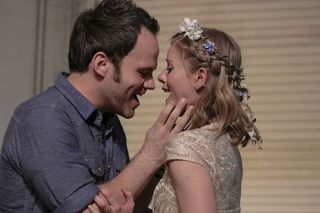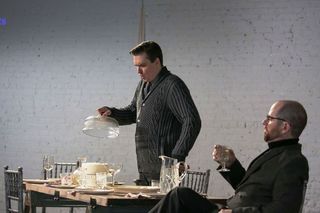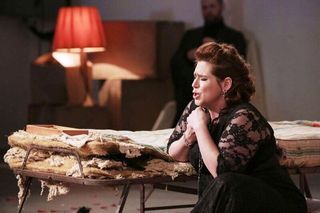|
Back
The Villain and The Saint New York
The Garage
06/20/2017 - & June 22*, 23, 24, 2017
Darius Milhaud: La Mère coupable, opus 412
Jennifer Black (Rosina), Amy Owens (Florestine), Marie Lenormand (Suzanne), Andrew Owens (Leon), Philip Cutlip (Count), Jeffrey Mattsey (Figaro), Matthew Burns (Bégearss), Christian Zaremba (Master Fal)
International Contemporary Ensemble (ICE), Geoffrey McDonald (Conductor)
Eric Einhorn (Director), Beth Goldenberg (Costume Designer), Shawn Kaufman (Lighting designer), On Site Opera (Producers)

Andrew & Amy Owens (© Fay Fox)
“I have no aesthetic rules or philosophy or theories. I love to write music. I always do it with pleasure, otherwise I just do not write it.”
Darius Milhaud (1892-1974)
Milhaud had no philosophy, perhaps, but his fecundity put him in a class with Teleman, Villa-Lobos and Vivaldi. And like them, when he was good, he was very very good. And when he was bad, he was...well, not that bad. Le Bœuf sur le toit and Scaramouche will live forever, his chamber music might survive for certain players, Kentuckiana is a personal favorite, his Jewish services are boring, and his operas are...well, varied.
This week and through the weekend, we can watch how Darius Milhaud (and his librettist wife, Madeleine) attempted to fill in Beaumarchais’ third Figaro drama. Mozart and Rossini took care of the first two epics about the wily valet and his promiscuous patrons. (And On Site Opera, perhaps the most innovative company in New York, gave us those two operas previously–in versions by other composers. But no composer until Milhaud ever attempted the last of the trilogy, and for good reason.
For a trilogy which supposedly ridicules 18th Century class structure, Beaumarchais’ The Guilty Mother is (excuse the expression) unclassifiable. Not comedy or tragedy, its light moments turn gloomy, fateful. When a lightly sarcastic dialogue commences, it darts into a dusty corner of religious extremism. The star-crossed young lovers are kept apart by stories of incest and intrigue. Many of the original characters are here, but are two decades older, they have taken lovers, given birth, they hate each other. The story is complex to begin with, becomes light and accessible, and then turns Byzantine with broken letter-boxes, mixed up portraits, enigmatic histories of legal, illegal, semi-legal and puzzlingly-almost-legal children.
Add to this the music, performed by the International Contemporary Ensemble under Geoffrey McDonald. While orchestrated by another composer, the chamber group has all the Milhaud trademarks. It is polytonal, jaunty, lyrical without melodies. Yet this has little to do with the movements on stage. Act One is all recitative (in French, with English subtitles on some of the walls), Act Two is a total change: it has long laments, semi-arias and ariettas, quartets, quintets and a happy ending echoing Mozart’s Figaro and of course The Rake’s Progress.
My one jump-out-of-seat moment came as all the characters save the villain realize that he is the one who has caused their misery. And as they call come together and shout together with a loud orchestral chord “Bégearss!!”, it was the actual echo of J.S. Bach’s crowd shout of “Barrabas” in St. Matthew Passion..
Coincidence? Possibly.
The saving grace to this semi-graceless opera–more than saving, an actual salvation–is Beaumarchais’ newly invented character of Monsieur (or Signor), Honoré Tartuffe Bégearss, who has inveigled himself into the Almaviva household (we never know why), possesses an almost Rasputin-ish way to make himself into a Saintly Beatific Presence, is revered by everybody except Figaro and his wife. The delightful reality is that Bégearss is more than a scoundrel or flimflam man. He is hustler, paranoid, lecher, a schemer for whom mendacity is as natural as breathing.
Eighteenth Century opera has dozens of characters who marry for money. Nineteenth Century opera has plenty of truly evil characters. But Honoré Tartuffe Bégearss makes your Scarpia or Iago positively impeccatant.
And taking the opera as a whole we have a strange potage. Bégearss’ machinations, the genuflections and supplications of Countess Almaviva, the now-a-bastard, now-legitimate kids The Guilty Mother seem like a combination of Little Foxes, Three Stooges, darkest Edward Albee and lightest Donizetti.
And this is what the estimable On Site Opera attempted to produce in two sections in The Garage, a one-time piano-warehouse near the Hudson River (611 West 50th Street, Between 11th & 12th Avenues) belonging to designer Kenneth Cole (Rather than change from a two-bedroom set to one dining room, the audience moved to a different part of the Garage during intermission, for no particular dramatic reason.)

M. DeLoach, M.Burns (© Fay Fox)
So first, let me say that I enjoyed it for the most inane motivation. Specifically, I’m a sucker for all-out sheer villainy. Especially villainy from an 1890’s melodrama. When the elegant Matthew Burns as Bégearss turns the two lovers into crybabies by lying about their origin, he almost snickers into his suit. (If he had a suit. He wears a sweater and jacket.) When he pressures the Countess to burn her love-letters, beating her vocally about her sins and wickedness, he is gleeful. When he knows that Figaro might be onto his game, he would almost twist his mustache into a sneer of dismay (if he had a mustache).
And in my absolute favorite moment, at the start of the second act, Mr. Burns trots out a wedding celebration cake, plunges his fingers into the middle of the cake and sings of his evil as he waves fingers and fork around the stage and the audience.
(Yes, it did indeed remind me of Our Leader bragging to the President of China about how he was cluster-bombing the Syrians all while raving about his chocolate cake.)
No, to his credit, Mr. Burns never ever overdoes his character. He is blasé, polished, he strolls about the stage with legato tranquility. And until we realize what evil he is hatching–and which he continues to hatch until the very last minute of the opera–he almost has the audience fooled that he is a man to be trusted.
Brrrr... (No wonder that Beaumarchais’ original title was The Guilty Mother or The Other Tartuffe. His audiences knew Molière’s character the way today’s audiences know Walter White.)
Fortunately, Mr. Burns is on stage (er...on Garage floor) virtually all of the 110-minute opera. Equally fortunately, director Eric Einhorn has assembled a case of uniformly splendid singing and, even more important acting.
Yes, Mr. Burns is the most subtle and the most terrifying, and his “cake aria” could have been part of Mozart. But the two lovers looked and acted well. Amy Owens was the coloratura soubrette incarnate, with the most effortless high notes when she was allowed to sing. Andrew Owens, alas, was suffering from “allergies”, and without an understudied, could whisper and narrate his role. But he looked good indeed.
The Figaro family–Marcus DeLoach and Marie Lenormand–were wise to the ways of evil, they plotted against their evil interloper, and sung, when necessary with most professional allure. The Count, a youthful Adam Cannedy, played with his role, sung broadly and well. Toward the end, bass Christian Zaremba comes on stage as the accountant. And while his scheming to keep money out of the hands of the play’s nemesis (to add complexity, the money comes from gold mined in Mexico, probably an important political point to Beaumarchais’ audiences) is complex, he was equally more than competent.

M. Black (with the ominous shadow of Bégearss) (© Fay Fox)
As for the title character, Jennifer Black’s Countess Almaviva sleeps the sleep of the guilty through most of Act One, but when she awakes, when she becomes the tortured servant to the terrifying Bégearss’, the entire opera changes emotional and musical course. What had been an 18th Century romp becomes, with her dark and rich soprano, dramatic import of any Grand Opera heroine.
Not that The Guilty Mother is the “grand” opera which Beaumarchais and Milhaud wished it to be. The story is too spotty, the music lacks a single memorable moment. Yet On Site opera never tried to make it look either “period” or ironic. One can slightly excoriate the complexity, the hybrid moods, the lack of musical memorability. But somehow, its villain, the returns of the original family, and the conniving intrigues have their own fascination. On Site Opera has taken up the challenge and succeeded a kind of triumph for a work which clumsily, awkwardly manages to stand aloft on its own ungainly feet.
Harry Rolnick
|